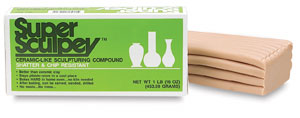Using Vaseline With Polymer Clay
I’ve already covered the use of Vaseline in a few of my tutorials but though I should also do a little write up on it under the tools section of this site. Vaseline, or Petroleum Jelly, is used to help non-baked clay, which I will refer to as new clay in this article, stick to baked clay. One of the benefits of working with polymer clay is that you can bake the sculpture multiple times during the sculpting process. This key advantage allows you to bake the sculpture in stages verses having to sculpt the entire piece before baking. Read the rest of this entry »













